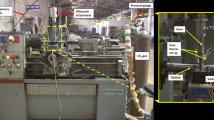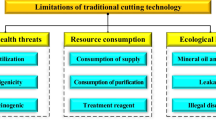Abstract
Precision involute artifact is an indispensable tool in the detection of high precision gears. In this paper, a new method of low-frequency vibration-aided wire electrochemical machining (LV-WECM) is proposed to fabricate gear involute artifact with high aspect ratio. First, a mathematical model of WECM is established to analyze forming principle of gear involute artifact. Second, the machining process is simulated by electric field simulation. The deviation of WECM is analyzed according to the simulation results. And then, the effects of low-frequency vibration and flushing on machining are analyzed by flow field simulation, which shows that vibration and flushing can effectively promote mass transfer in the gap. Finally, the effects of applied voltage, pulse parameters, and vibration parameters on machining accuracy were discussed experimentally. After several groups of contrast experiments, a gear involute artifact blank with aspect ratio of 40:1 is successfully machined on 8-mm-thick GCr15 workpiece, the max profile deviation is 17.6 µm, and the average surface roughness Sa is about 2.370 µm. It is proved that LV-WECM is a reliable method for machining involute template with high aspect ratio.




















Similar content being viewed by others
Data availability
All data generated or analyzed during this study are included within the article.
Code availability
Not applicable.
References
Ling SY, Lou ZF, Wang LD et al (2013) xperimental research on precision grinding for high-grade involute artifact[J]. J Dalian University of Technology 53(4):508–513
Frazer RC, Bicher R, Cox B et al (2003) An international comparison of involute gear profile and helix measurement[J]. Metrologia 41(1):12
Takeoka F, Komori M, Kubo A et al (2009) High-precision measurement of an involute artefact by a rolling method and comparison between measuring instruments[J]. Meas Sci Technol 20(4):045105
Jain VK, Pandey PC (1980) An analysis of electrochemical wire cutting process using finite element technique[C]. Proceedings of the Twentieth International Machine Tool Design and Research Conference: Sub-Conference on Electrical Processes, London
Sueptitz R, Dunne P, Tschulik K et al (2013) Electrochemical micromachining of passive electrodes[J]. Electrochim Acta 109:562–569
Volgin VM et al (2016) Modeling and numerical simulation of electrochemical micromachining[J]. Chem Eng Sci 140:252–260
Zhou Z, Fang X, Zeng Y, Zhu D (2021) Research on machining gap distribution in wire electrochemical micromachining. J Electrochem Soc. 168:043503
He H, Zeng Y, Yao Y et al (2017) Improving machining efficiency in wire electrochemical micromachining of array microstructures using axial vibration-assisted multi-wire electrodes[J]. J Manuf Process 25(JAN):452–460
Maity S, Debnath S, Bhattacharyya B (2020) Modeling and investigation on multi-wire electrochemical machining (MWECM) assisted with different flushing strategies - ScienceDirect[J]. J Manuf Process 57:857–870
Jiang K, Wu X et al (2018) Vibration-assisted wire electrochemical micromachining with a suspension of B4C particles in the electrolyte[J]. Int J Adv Manuf Technol 97:3565–3574
Qu N, Fang X, Wei L et al (2013) Wire electrochemical machining with axial electrolyte flushing for titanium alloy[J]. Chin J Aeronaut 26(1):224–229
Xiaolong F, Xianghe Z, Pengfei Z et al (2016) Improving machining accuracy in wire electrochemical micromachining using a rotary helical electrode[J]. Int J Adv Manuf Technol 84(5–8):929–939
Fang XL, Zou XH, Chen M et al (2017) Study on wire electrochemical machining assisted with large-amplitude vibrations of ribbed wire electrodes[J]. CIRP Annals Manuf Technol 66(1):205–208
Gao C, Qu N, He H et al (2019) Double-pulsed wire electrochemical micro-machining of type-304 stainless steel[J]. J Mater Mach Technol 266:381–387
Xu K, Zeng Y, Li P et al (2015) Study of surface roughness in wire electrochemical micro machining[J]. J Mater Mach Technol 222:103–109
Ling S, Li M, Liu Y et al (2020) Improving machining localization and surface roughness in wire electrochemical micromachining using a rotating ultrasonic helix electrode[J]. Micromachines 11(7):698
Shin HS, Kim BH, Chu CN (2008) Analysis of the side gap resulting from micro electrochemical machining with a tungsten wire and ultrashort voltage pulses. J Micromech Microeng 18:075009. https://doi.org/10.1088/0960-1317/18/7/075009
Fang X, Zhang P, Zeng Y et al (2016) Enhancement of performance of wire electrochemical micromachining using a rotary helical electrode[J]. J Mater Process Technol 227:129–137
He H, Qu N, Zeng Y et al (2016) Machining accuracy in pulsed wire electrochemical machining of γ-TiAl alloy[J]. Int J Adv Manuf Technol 86:2353–2359
Meng L, Zeng Y, Zhu D (2018) Helical carbon nanotube fiber tool cathode for wire electrochemical micromachining. J Electrochem Soc 165:E665–E673
Meng L, Zeng Y, Zhu D (2019) Wire electrochemical micromachining of Ni-based metallic glass using bipolar nanosecond pulses[J]. Int J Mach Tools Manuf 146:103439
Wu X, Li S, Jia Z et al (2019) Using WECM to remove the recast layer and reduce the surface roughness of WEDM surface[J]. J Mater Process Technol 268:140–148
Xu K, Zeng Y, Li P et al (2016) Effect of wire cathode surface hydrophilia when using a travelling wire in wire electrochemical micro machining[J]. J Mater Process Technol 235:68–74
Zou X, Fang X, Chen M et al (2017) Investigation on mass transfer and dissolution localization of wire electrochemical machining using vibratory ribbed wire tools[J]. Precis Eng 51:597–603
Debnath S, Kundu J, Bhattacharyya B (2018) Modeling and influence of voltage and duty ratio on wire feed in WECM: possible alternative of WEDM. J Electrochem Soc 165:E35–E44. https://doi.org/10.1149/2.0601802jes
Chen XL, Zhu JJ, Xu ZZ, Su GK (2021) Modeling and experimental research on the evolution process of micro through-slit array generated with masked jet electrochemical machining. J Mater Process Technol 298:117304
Funding
The authors acknowledge financial support from the sub-project of the National Key R&D Program (2018YFB2001400), the National Natural Science Foundation of China (no. 52005298), and the Natural Science Foundation of Shandong Province (no. ZR2021ME048).
Author information
Authors and Affiliations
Contributions
Li Liuxin performed the experiment, contributed significantly to analysis and manuscript preparation, performed the data analyses, and wrote the manuscript; Liu Yong contributed to the conception of the study and edited the manuscript; others helped perform the analysis with constructive discussions.
Corresponding author
Ethics declarations
Ethics approval
This study complies with the ethical standards.
Consent to participate
All authors agreed with the consent to participate.
Consent for publication
All authors have read and agreed to the publication of the paper.
Competing interests
The authors declare no competing interests.
Additional information
Publisher's note
Springer Nature remains neutral with regard to jurisdictional claims in published maps and institutional affiliations.
Rights and permissions
Springer Nature or its licensor (e.g. a society or other partner) holds exclusive rights to this article under a publishing agreement with the author(s) or other rightsholder(s); author self-archiving of the accepted manuscript version of this article is solely governed by the terms of such publishing agreement and applicable law.
About this article
Cite this article
Liuxin, L., Yong, L., Siying, L. et al. Theoretical and experimental study on LV-WECM of gear involute artifact with high aspect ratio. Int J Adv Manuf Technol 124, 3453–3469 (2023). https://doi.org/10.1007/s00170-022-10752-9
Received:
Accepted:
Published:
Issue Date:
DOI: https://doi.org/10.1007/s00170-022-10752-9




